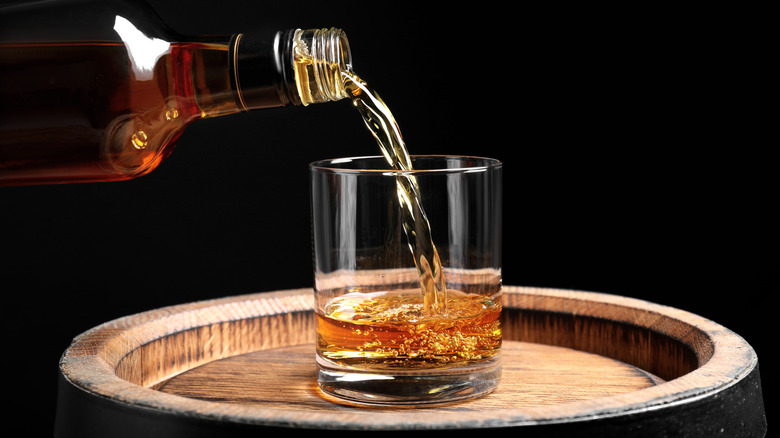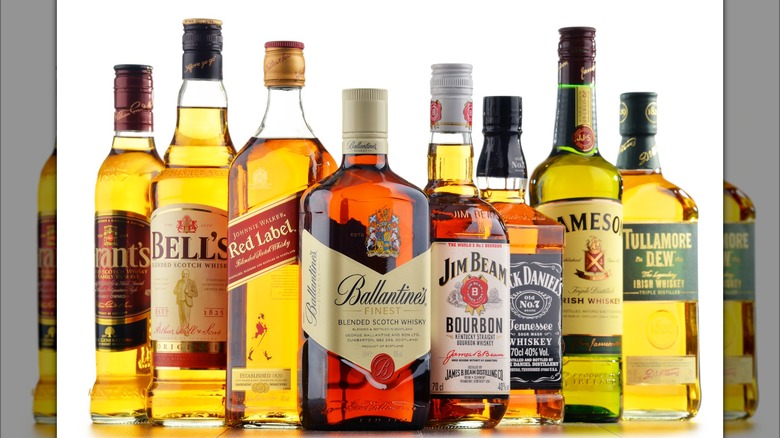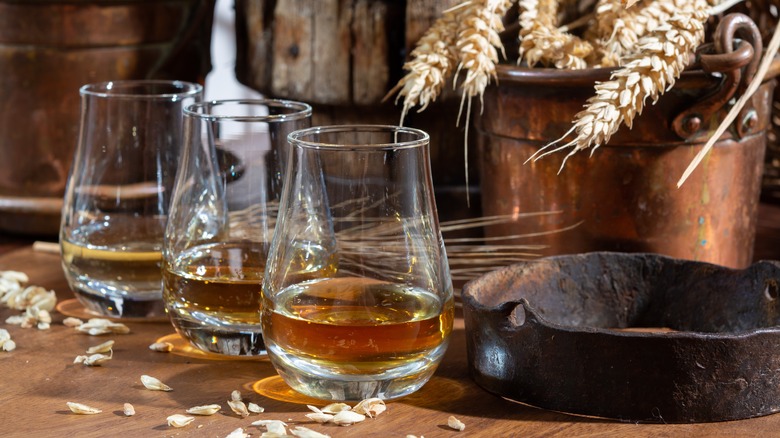Whiskey Vs Scotch: What's The Difference?
In the world of brown liquors, sorting drinks into definitive categories can get confusing, fast. While there is a lot going on behind the scenes, the most simple distinction between whiskey and Scotch whisky is where they are made. Use the spelling difference between whiskey and whisky to keep this straight — the "ey" versus "y" ending denotes where each spirit is from.
Scotch refers to whisky made in Scotland. It must be matured for three years in oak casks, and the base can only be made up of cereal grains, water, and yeast. Whiskey, on the other hand, refers to all whiskey made in the United States or Ireland, and each country has its own set of mandates. Most broadly, American whiskey must start with a base of grains. The same is true for Irish whiskey, and similar to Scotch, it must age for three years in wooden casks.
Depending on the specific subcategory of Scotch or whiskey (of which there are many), there will be different legal requirements regarding fermentation, filtration, barrel aging, and more. The grains used in the base — such as corn, barley, rye, and wheat — can vary in proportion, with some products using only one, and others using all of those and more.
The main types of whiskey and Scotch
Whiskey from the United States is primarily defined by the grain that makes up the majority of the mash bill, such as corn, wheat, or rye whiskey. For example, bourbon and Tennessee whiskey are two popular American styles that are made primarily with corn.
Irish whiskey and Scottish whisky use more specific terminology than the United States. Products from Ireland fall into four categories: blended, single malt, single grain, and single pot still. Scotch falls into five categories: single grain, blended grain, single malt, blended malt, and blended Scotch. While there are several specifications around aging requirements and the number of distillations, the main distinction between these categories is the type of grain and whether the product is made at a single distillery or blends spirits from multiple distilleries.
Single malts from both Ireland and Scotland include just malted barley, and are made at one distillery. Single grain uses a mix of cereals, and is made at one distillery. In Scotland, when you mix single malts or single grains from more than one distillery, you get blended malt Scotch whisky and blended grain Scotch whisky, respectively. In Ireland, the comparable products would all simply fall under the term "blended." You may think that blended whiskey in the United States would be similar, but that is not the case. American blended whiskey need only contain 20% straight whiskey, and other types of whiskey or neutral grain spirits can make up the remainder.
The flavor profiles of whiskey and Scotch
Unless the whiskey and Scotch are using the exact same grains, comparing the flavor notes is like comparing apples and oranges. For example, bourbon whiskey — which must contain at least 51% corn — leans sweet with vanilla and caramel notes, but American rye whiskey tends to be spicy. In general, Irish whiskey is known for being fruit-forward and smooth, while tasting notes for Scotch can include citrus, vanilla, spice, and complex peat.
Single malt Scotch whisky — perhaps the most iconic variety of Scotch — tends to be spicy, woody, earthy, and distinctly smoky. Unlike single malt Irish whiskey, single malt Scotch whisky is known for the distinct medicinal, herbal, or charred flavor of the burned peat that is often used to flavor the grains. This process is not a requirement, but rather a holdover of Scottish tradition. That being said, all these trends have many, many exceptions.
An appropriate comparison would be sampling single malts from Ireland, the United States, and Scotland, which would all be made with just malted barley. However, even if all other factors were the same, the simple fact that these single malts are made in different places would have an effect on the taste because of the type of yeast, the source of the barley, the climate, and the particular touch of the producer. For that same reason, there are flavor differences between Scotland's whisky regions, too.



